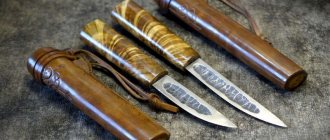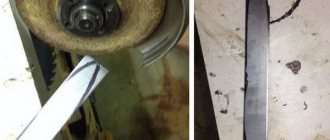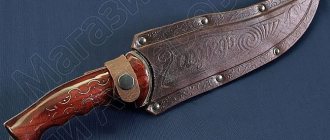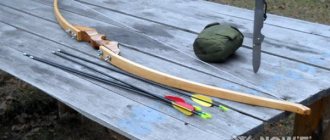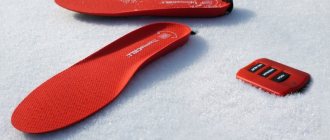You can make a knife from damask or Damascus steel, an old file, a shovel, even wood. First, a shape is selected in accordance with the purpose of the weapon and a sketch is made. A metal blank is cut out using a machine or a grinder saw, and it is narrowed from the butt to the blade. And the handle can be made of wood, plastic, micarta, and attached using metal rivets.
The sheath is made of leather or rough fabric. The blade must be hardened in a forge furnace at a temperature of 700 C, cooled, and tempered in an oven heated to 200 C, only then will the weapon be of high quality.
How to make a knife: preliminary preparation
To make a real knife of any model, you need:
- Draw a sketch. It is important to consider the dimensions of the product and the type of handle attachment.
- Create a steel blank. You can remake an old file, shovel, or other unnecessary tool, or buy a piece of grade steel grades 95Х18, 50Х14МФ, Х12МФ, ХВГ.
- Cut the outline on a milling machine or using a hacksaw. To eliminate imperfections, it is better to use a milling cutter, but you can also use an emery sharpener. At the same stage, holes are made in the metal part of the handle (shank) for fastening the linings and slopes on the blade.
- Harden the metal in a furnace and temper the steel. This will make the knife more durable. Use a forge furnace.
- Make lining for the handle. Wood is suitable as a material, but also plastic, soft metals, and brass.
- Assemble the product. The shank is attached to the shank using adhesive and selected trim fasteners. At this same stage, the blade is finally sharpened and the weapon is polished.
To complete the task, you need tools and materials, but it is also important to understand the ban on creating bladed weapons.
We recommend reading the article on the best switchblades. From it you will learn about the main characteristics of switchblades, their types, and handmade switchblades. And here is more information about the best throwing knives.
What to make from
The knife can be made from:
- A piece of stainless steel that was previously a pan, pipe, or piece of furniture. This is the simplest option, but the product will have to be sharpened often.
- An old saw, file or hacksaw. They are made of a material that does not dull for a long time, but the product will be fragile and susceptible to corrosion.
- Planer blades. The metal will first have to be heated to give it the desired shape, and this type of steel will quickly rust if not cared for.
The knife can be made from an old scythe or the cutting element of a lawn mower, or a drill of a suitable size. The main thing is that the workpiece material is larger in length and thickness than the product that will be created from it.
What metal?
The knife is made of metal with the following qualities:
- resistance to abrasion during operation, deformation;
- immunity to high temperatures;
- strength, that is, the tool should not break under load;
- viscosity, therefore, retention of the original shape after repeated use;
- hardness that does not allow other inclusions to disturb the structure of the steel;
- resistance to corrosion.
Several types of steel meet these conditions:
- damask and damask, but they are difficult to work with at home;
- 95X18, which can be hardened to high strength;
- 50Х14МФ, does not dull for a long time;
- X12MF, hard and “long-lasting”, but requiring careful care;
- HVG, capable of withstanding high loads without compromising the quality of the knife;
- 50HGA, not afraid of harsh operating conditions, but susceptible to corrosion;
- 40X13, spring, like the previous type, stainless, but not very durable.
What other material is needed?
In addition to the steel sheet, you will need a choice of material for making handle linings:
- animal bone or horn;
- wood (birch, pear, oak, ash, maple, apple tree);
- plastic, plexiglass;
- expensive metal alloys (gold, silver, bronze);
- textolite, ceramics, ebonite;
- brass.
Watch the video on how to make a knife from bone:
Instead, a thick cord or electrical tape may be useful if you need a very simple and small knife. They wrap the shank.
With a higher quality and more complex handle, parts and means are needed to attach it to the base:
- rivets;
- hairpins;
- bolts and nuts;
- glue, epoxy resin.
To process the blade you will need oil to cool the steel, sandpaper, and different types of grinding pastes.
Screw Sandpaper Epoxy resin A block of wood for making a knife handle
Making tool
To make a knife at home, the following tools are required:
- metal hacksaw, grinder saw or grinder, sharpening machine;
- vice;
- forge furnace and tongs;
- a drill or drill for making holes for attaching the handle;
- file;
- safety glasses and earplugs.
How to make a blank
The workpiece must be made so that the blade and shank form a single whole:
- draw a sketch on cardboard, observing the proportions of the knife model you like, cut it out;
- place the template on a steel sheet and outline it; Blade preparation
- cut the workpiece with a grinder or a hacksaw on a machine;
- drill holes on the shank for fastenings;
- make all bends and angles more precise, remove roughness by processing on a sharpening machine;
- mark and perform descents on the blade;
- harden the workpiece in an oven at 200 C, cool;
- clean the metal, go over it again, using a machine with a coarse-grain emery attachment;
- finish it with sandpaper with an index of 400 units, that is, the finest;
- grind the workpiece, after holding it in a vice;
- polish first with diamond paste, then on a feta wheel and finally with polishing paste.
How to make a blade
The blade, that is, the cutting part of the tool, should be done like this:
- mark the bevels on the workpiece cut out of steel in accordance with the knife model;
- holding it in a vice, grind off the excess layer of metal on both sides of the blade, but not completely;
- Finish the lines as intended using a belt sander or by hand.
Knife model Knife preparation
This difficulty in sharpening the blade is due to the fact that it cannot be made too thin, because then there is a stage of hardening the blade. And it may turn out to be of poor quality or fail at all, that is, the knife will turn out fragile.
What are the risks of making bladed weapons at home?
The production of edged weapons by craftsmen at home is punishable by Part 3 of Article 223 of the Criminal Code of the Russian Federation, that is, a prison term of up to 2 years.
You can make knives with the following indicators:
- blade length up to 9 cm;
- butt width up to 2.6 mm.
Structure of a knife
Such tools are not prohibited for manufacture and use. If the product comes out larger, you cannot sharpen it too sharply, make a handle with finger grooves more than 4 mm deep and a guard.
Manufacturing process
When thinking about how to make a knife with your own hands at home, the first thing you need to do is acquire tools. We will need:
- Hacksaw for metal.
- Files: one large, and the rest are smaller.
- It is not necessary to have a vice, but with them the process will be more convenient and faster.
- Sandpaper.
- Drill.
- Hammer.
- An anvil or piece of rail.
We take a broken or unnecessary garden tool and draw a sketch of the future knife on it. Then we begin to create this form. To do this, you can use a drill: drill many holes according to the shape of the workpiece, then break off the excess and smooth the surface. If the shape of the knife is simple, then we immediately begin sawing with a hacksaw. To do this, it is easier and more convenient to clamp the material in a vice - this way it will hold tightly without jumping out. When the shape is cut, it needs to be finished with a file. Where it is necessary to remove a lot of metal, use a large file, and then process it with a smaller one. So, the knife blank is ready, let’s move on to understanding how to make a knife with your own hands.
Advantages of a DIY knife
A knife made by yourself has many advantages compared to factory products:
- meets the requirements of its owner;
- with the right choice and good heat treatment, steel is of high quality, but costs less;
- has the appearance that the owner likes;
- it does not contain any defects found in finished products.
DIY knives
Advantages and disadvantages of bone knives
Knives with a bone die have a number of advantages over classic models. Firstly, they have an aesthetic appearance. Secondly, the high strength of such bladed weapons deserves undeniable respect among professional hunters and fishermen. Such products are durable and reliable.
However, bone knives also have disadvantages. So, many people do not like them because the surface of the bone is too smooth, especially if there are no grooves for the fingers.
The simplest homemade knives
Homemade knives, as simple as possible, are obtained from:
- scissors of different sizes;
- bayonet shovel;
- old knife;
- saw, hacksaw;
- car springs.
You can even make a product from a fairly thick stick. The simplest option is a homemade knife with a wooden handle. And if you use a file as a base, you can do the work without power tools.
Watch the video on how to make a knife from a bearing:
From scissors
Scissors can even make 2 knives for household needs if they are:
- divide into 2 parts by pulling out the fastening from the center;
- take one half, process the blade on a sharpening machine to the required thickness (the dull side is the butt, the sharper side is the blade);
- make slopes, sharpen a sharp edge;
- make suitable linings from wood, make recesses in each corresponding to the thickness of the metal part of the handle;
- attach the wooden parts using glue and fasteners screwed into the hole left from the scissors;
- Give the handle its final shape, remove any burrs, and polish it.
Take one half and process the blade. Make a handle of suitable size from wood. Attach the wooden parts with glue. Give the handle its final shape.
The knife will come with a ring at the head of the handle, left over from the scissors.
From a piece of metal
From a piece of metal, if it is large enough, you can make any type of product. First, a sketch is prepared on paper, then a blank is cut out using this pattern. It is processed on a machine, bringing the blade into the desired form. 2 holes for bolts are drilled on the shank.
If the metal needs to be hardened, this is done using a forge furnace, and the steel is tempered. After cleaning, grind and polish the metal part. After cutting out the pads, they are attached to the handle using industrial glue and metal fasteners. If they stick out, this part should be cut off and sanded so that it does not interfere with holding the knife.
From a shovel
A shovel can be used to make any kind of knife as long as they don't have to cut very hard objects. Because this steel is usually of low quality and bends easily, even if the tool is bayonet-type. The manufacturing stages do not differ from what was described above. But due to the fragility of the metal, it must be hardened. And the handle should be made with wooden plates as long as the shank.
From an old knife
You can make a new tool out of an old knife if you simply replace the handle pads. To do this, the product will have to be disassembled. You can change the type, and hence the purpose, of a weapon if it is large enough. All you have to do is cut a blade of a different shape and combine it with an updated handle. The steel does not need to be hardened since it has already been heat treated at the factory.
From a stick
From a stick, that is, a knot with a diameter of 3-4 cm, you can make a fairly sharp weapon:
- cut a piece about 15 cm long;
- turn a blade about 6 cm on a lathe, the remaining 9 cm will be a handle;
- thin the sharp edge using a machine with an emery attachment;
- bring the blade to the maximum possible sharpness using an abrasive stone.
The quality of the product cannot be compared with metal, but it can be used for cutting.
From other available materials without tools
A knife can be made from scrap materials and, in addition to those mentioned above, from:
- a mechanical saw, the blade of which has good cutting properties;
- hacksaws for wood, they make decent kitchen tools;
- automobile springs requiring forging and heat treatment;
- a large drill, but it also needs to be heated and given the desired shape.
After converting the scrap material into a flat sheet, the manufacturing technology is still the same:
- drawing on paper;
- cutting a metal blank;
- sharpening, hardening, finishing;
- handle manufacturing, assembly.
A sample drawing of a knife on paper.
A knife without tools such as a band saw or grinder can be made from a file. It is enough to heat it with a blowtorch and let it cool so that the metal can be processed with a hacksaw. This is what gives the workpiece the desired shape. Then heat treatment is carried out, grinding with hand tools and emery. And you can assemble the product.
Using skeletal bones as a handle
Also, the handles of bladed weapons are made from deer, elk and antelope bones. You can find folding knives made from the skeletons of animals such as sheep and goats. Since such material often has rather large sagging and folds on its surface, it is difficult for the master to grind it. Because of this, products made from the bones of these animals are not cheap.
Only large-sized skeletal bones are used to make bladed weapons. Basically, these are limbs in the form of long tubes, the wall thickness of which does not exceed 10 mm. They are either sawed out, making smooth white plates, or cut crosswise, making sleeves, which are subsequently put on the handle of the knife.
DIY knife at home from start to finish
You can make a knife of any kind with your own hands at home, if you have the tools, material for the blade and handles, fixing pins, and glue. Production available:
- small or large implements;
- hunting;
- marching;
- kitchen;
- wooden;
- homemade folding;
- forged;
- dagger type.
From start to finish, you create a knife with your own hands in stages:
- choose steel for the blade (preferably carbon or tool steel);
- draw a sketch, where the dimensions of the product are marked in accordance with the purpose, the shape is determined;
- cut out the workpiece, make holes on it for fastening the linings;
- subject the metal to forging, hardening and tempering;
- overlays are made and attached to the frame.
If desired, a knife can be made on the go from wood, quartz, a tin can, and other available materials.
Made of wood
It is better to make a monolithic product from wood for greater strength. You need to take a metal knife as a sample, mark the lines of the handle, the cut of the blade and the blade. The excess is removed with a hacksaw and a pen tool, since the work is quite delicate. When the whole weapon is ready, it is sharpened using a whetstone.
Switchblade made of wood Monolithic knife made of wood
Hunting knife
A hunting knife is made using:
- carbon steel;
- brass and wood for the handle;
- steel pins and epoxy glue during assembly.
The technique is the same as given earlier, but there are some nuances:
- you need to make fullers on the blade;
- for more accurate formation of bevels, a caliper is used in measurements;
- metal requires hardening in a forge and tempering;
- brass linings on the handle are hidden under wooden ones.
Kitchen knife
A kitchen knife is made of spring metal (for example, a hacksaw), which, after cutting the workpiece, is heated in an oven and cooled in oil or air. Hardening is carried out at a temperature of 200 C.
The bevel can only be made on one side. After this, the knife is sharpened using a damp whetstone. If it has a wooden handle, oak (or ash, pear) linings are impregnated with linseed oil. Apply it with a brush or swab, wait 20 minutes for absorption, remove excess and dry for several hours. Then you need to spread another layer. After drying, the knife can be assembled.
Dagger
The dagger differs from other types of products in that both edges of the blade are sharp. This means that bevels are made on both sides, just like sharpening. Otherwise, the technology and set of tools do not change.
Forge a knife
To forge a knife, you need to prepare:
- A stove with thick walls, where charcoal will burn and air access will be provided. This way it will be possible to reach temperatures of up to 900-1200 degrees.
- Hammers weighing 4 kg and 1 kg, as well as an anvil or its imitation. You will also need tongs to remove the hot product from the oven.
How to forge a knife at home:
- heat the metal in the oven to 900 degrees, that is, until it turns orange;
- remove it with tongs, place it on the anvil;
- tap with hammers to give the desired shape and thickness.
After this, you can cut out a blank corresponding to the drawing.
If the knife is made from a file, an old product, a saw, it only needs hardening:
- heating in an oven to 700 C (the metal will become cherry color);
- placing in heated oil to cool or leaving in air;
- sending to an oven heated to 200 C;
- cleaning from scale with sandpaper.
small knife
A small knife requires more accurate measurements when marking slopes, precise movements when cutting a metal workpiece, but in general the process is no different. For a small product, almost any piece of steel will do. That is, you won’t have to forge it; it will be enough to provide hardening and tempering before assembly.
Mini-knives made by yourself do not even need to make linings for the handle, since the shank can be wrapped with a thick cord or electrical tape. If desired, make a wooden cutting using standard technology.
Big knife
It is more practical to make a large knife from a piece of tool steel purchased at a hardware store. There are no differences in the manufacturing process, except that:
- You need to make a fuller on the blade near the butt. It is done with a file, making the tool lighter and stronger.
- It is necessary to drill holes in the handle for attaching the linings and additional ones. The latter are needed to reduce the weight of this part of the product.
- It is imperative to harden and temper the workpiece. It is heated in an oven until cherry-colored, after which it is placed in oil. And then the blade is kept at a temperature of 200 C and cooled.
- The linings should be made of lightweight materials, but wide enough. Textolite and plastic are suitable, which are glued in 3 layers. This will make the knife heavier in the blade area, which will make it possible not only to cut, but also to chop with it.
For the forest
Forestry tools are manufactured following the same steps as others, but:
- it should be small with a blade that is not too wide;
- have straight or concave slopes;
- the edge should be made like a Finnish or Scandinavian knife, that is, less than 70 degrees;
- use wood for the handle.
You can make a knife in the forest from oak or pine (these are hardwoods), pieces of silicon, quartz, glass, or even a tin can. If you find a metal part, you can build an improvised furnace and forge a blade. The handle is wrapped in fabric, tufts of grass or made of wood.
Homemade folding
A homemade folding knife is made from the same materials as previous versions, and the technology does not change, but:
- You will also need a brass pin to hold the blade in the open position;
- the cutting part should be shorter;
- blade head - have a hole for screwing fasteners into the handle and a tooth to cling to a brass pin;
- the handle is made of two wooden parts (outer layer) and the same number of Kydex material elements (inner);
- On all parts, holes are drilled for the blade retainer and handle, and below and to the right - a brass pin.
Camping knife
A camping knife is made according to the same scheme as described earlier, but it is important to observe the parameters of the weapon:
- classic blade no more than 100 mm, so as not to take up much space in the backpack;
- the most comfortable handle and bright lining for easy searching if you get lost;
- the thickness of the butt is not less than 2.5 mm, and the blade is 1 mm;
- a fixed blade with a fuller, since a homemade folding one can fail.
You will also need a tool case.
How to assemble a knife
To assemble a homemade knife, you should:
- make 2 holes for clamps on the metal part of the handle;
- drill the same grooves in the linings;
- glue the component parts of the cutting with epoxy or other industrial glue, if it consists of several layers, dry it by squeezing it with clamps;
- attach the finished linings to the shank using pins;
- If parts of the fasteners stick out after screwing, they need to be cut off and these places sanded.
Horns as decoration
The horns of killed animals have a dense fibrous structure. When processing such material, a very attractive pearlescent shimmer appears.
Speaking about the popularity of such shoots as a material for making bone knives, we can firmly state that in the world you cannot find a species of animal whose horns do not adorn the handle of some bladed weapon. However, most often craftsmen prefer to use bull horns. This is explained by the fact that from an array of this material you can easily obtain a workpiece of the desired size. The steamed horn of this animal under pressure takes on any, even the most intricate, shape, while the material does not break and cracks do not form on it.
Blades with black horn handles were especially prized. This is due to the high strength of this material. It does not collapse even with strong impacts.
If the bone is mounted entirely in the form of a pipe, then it is better to choose a small horn. The finished handle made of this material lies comfortably in the hand, as if it merges with the hand of the weapon owner. The fingers are clearly fixed in the optimal position.
In Russia, the most popular material for making a knife handle is deer or elk antler. The wrinkled shell of such a natural material resembles the bark of an old tree; thanks to this property, the craftsman does not need to additionally process the workpiece. The processed turtle shell is inimitably beautiful. It is thanks to its magnificent appearance after polishing that craftsmen fell in love with this natural material. They decorate almost any weapon that exists in the world, from hunting rifles to knives.
Since the horns are quite strong and have sufficient toughness, there is no need to strengthen them with rings and sleeves.
Making knives at home
Making a homemade sheath at home includes the following steps:
- making a pattern from paper (you need to put a blade wrapped in tape on it, add 1.5 cm from each edge and circle);
- creating a pattern from leather or thick fabric (the pattern is traced 2 times in a mirror image);
- cutting out from the material 2 side inserts 1.5 cm wide and a T-shaped part, which will then become a clasp;
- processing the edges of the cross element with wax, grinding on a felt wheel of the machine;
- sewing a T-shaped part and one of the main patterns with nylon thread;
- gluing the inserts of this part of the sheath;
- fixing the second half of the pattern with glue;
- turning the edges of the workpiece on a grinding machine;
- stitching glued parts;
- polishing the surface of the sheath, applying cream if it is leather;
- making holes at the ends of the fastener to secure the button parts.
Watch the video about how the knife is made:
DIY myocardium for a knife
Do-it-yourself myocardium, or micarta, for a knife is made from several layers of dense fabric of different colors (for example, denim) and epoxy resin (10 parts to 1 part hardener). The material is cut into equal strips. They need to be placed in a container where the mixture with resin has already been poured so that the fabric is saturated. This multi-layer “cake” is then taken out and pressed tightly with your hands to remove air and excess liquid.
Now you need to wrap it in wax paper and place it between two wooden planes, holding it with clamps. After 2 days, micarta is ready.
Knife assembly
You can glue both parts of the bone knife handle with epoxy or regular second glue, which is designed for gluing metals and natural materials (animal bones). After the surfaces are glued and aligned, you should add a little more glue on top so that it fills all the microcracks. Next, you need to firmly clamp the product into the clamp so that excess glue flows down. They need to be removed as quickly as possible with a cloth soaked in acetone. Now all you have to do is wait a little until the glue dries completely.
DIY knife blades
Knife blades are made by hand:
- according to a sketch, which is an image of the entire product, and not just the cutting part;
- from a steel sheet using a band saw or grinder saw;
- with drilling holes for fastening handle linings;
- with machine grinding or filing;
- with the formation of bevels;
- with hardening in a furnace and cooling in oil or air;
- with tempering, that is, baking in the oven at a temperature of 200 C and cooling in it;
- cleaning with a grinding machine or by hand.
